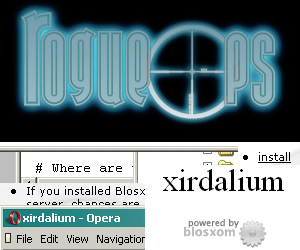blogging and mapping
 The last week was pretty much filled with two major tasks: Finally setting up this weblog and working on the map I am contributing to the Max-Payne-2 modification “Rogue-Ops”. Unfortunately I can’t show off any screenshots of my map yet, as looks and contents of it still are secrets to be kept inside the team. [Screenshots of my contributions to the mods Lightsaber 4.0, 5.0, the first chain map project, and the real world can be seen at the exhibition-section of maxmod, my project’s website.] To get an idea of Rogue-Ops visit the website and its media-section. The mod progresses at astounding speed and professional-standard quality. Once again I am amazed by the skills of gamemodders, their willingness to invest very much—and I mean very much—time into a mod, and especially by the power of self-organization featured by modding-teams. The longer my fieldwork lasts, the surer I become that this indeed is a worthwhile issue to be taken care of by sociocultural anthropology—and that doing “thick participation” is the only way to gain real access and understanding.
The last week was pretty much filled with two major tasks: Finally setting up this weblog and working on the map I am contributing to the Max-Payne-2 modification “Rogue-Ops”. Unfortunately I can’t show off any screenshots of my map yet, as looks and contents of it still are secrets to be kept inside the team. [Screenshots of my contributions to the mods Lightsaber 4.0, 5.0, the first chain map project, and the real world can be seen at the exhibition-section of maxmod, my project’s website.] To get an idea of Rogue-Ops visit the website and its media-section. The mod progresses at astounding speed and professional-standard quality. Once again I am amazed by the skills of gamemodders, their willingness to invest very much—and I mean very much—time into a mod, and especially by the power of self-organization featured by modding-teams. The longer my fieldwork lasts, the surer I become that this indeed is a worthwhile issue to be taken care of by sociocultural anthropology—and that doing “thick participation” is the only way to gain real access and understanding.
The other thing that occupied me was installing and configuring blosxom, the software I chose for my weblog. ‘Chose’ is only partially correct, as it was recommended to me by KerLeone, whom I own huge tnx for setting me on the right path and helping me a lot by his expert advice. Blosxom may seem a somewhat geeky choice, as you have to configure quite something to make it run and look like you want it to — on the other hand it’s absolutely straightforward, clear-as-glass written and tremendously moddable and extensible. Once you understand how it functions you have absolute control about your blog. And that is exactly what I need for my project. When a cyberanthropologist creates his blog, it is like the anthropologist building his hut. In my case it, like mapping, means at the same time to share a part of “my tribe’s” practice — appropriating software, diving into it, creating something of your very own, and making it available for free to other people—in this case making it run on the Internet.

